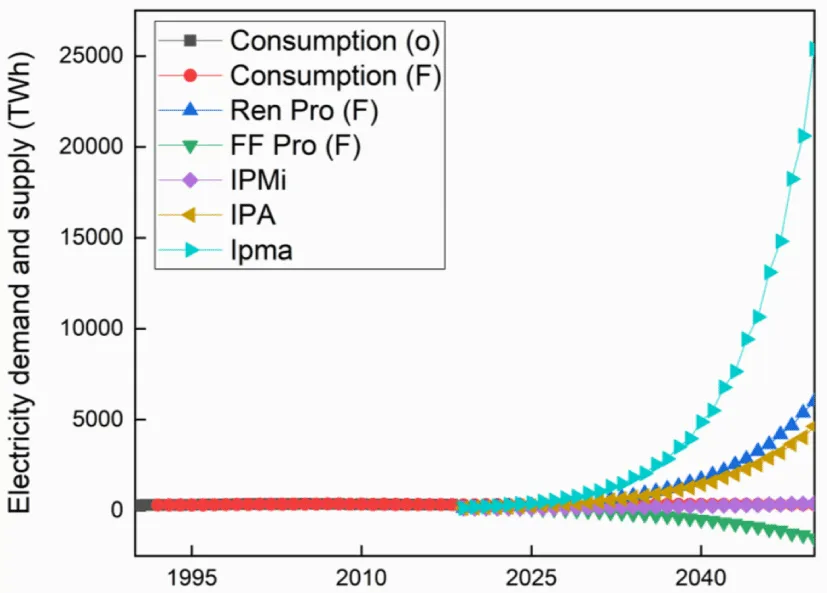Annals of Environmental Science and Toxicology
Transition Pathways Towards 100% Sustainable Electricity Generation for America Using Demand and Supply-side Determinants
Mark Agyei-Sakyi*
Saint Joseph’s University, 5600 City Ave, Philadelphia, PA 19131, USA
Cite this as
Agyei-Sakyi M. Transition Pathways Towards 100% Sustainable Electricity Generation for America Using Demand and Supply-side Determinants. Ann Environ Sci Toxicol. 2024;8(1):074-076. Available from: 10.17352/aest.000082Copyright
© 2024 Agyei-Sakyi M. This is an open-access article distributed under the terms of the Creative Commons Attribution License, which permits unrestricted use, distribution, and reproduction in any medium, provided the original author and source are credited.In most countries, energy resources and electricity generation have become the engine of economic growth. This study analyses effective and sustainable energy transition pathways and supply and highlights the commitments of the 2015 Paris Agreement by the United States of America in combating the challenges of global warming. The transition pathways are designed to reduce greenhouse gas emissions and advance worldwide temperature to a 1.5 °C average. Again, justifiable transition pathways mostly include energy savings on the demand side, generation efficiency, and fossil fuel substitution by various renewable energy sources and low-carbon nuclear. Renewable energy conversion approach to constantly remain precise strategic and beneficial, policy initiatives are necessary to steer the global electricity transition toward a sustainable energy and electricity scheme. In furtherance, the estimation of electricity output in emerging and industrialized economies, output, and demand projections affect economic planning and decision-making. Electricity generation and consumption impact the rate of technological advancement, GDP growth, industrialization, and infrastructural development. Most macroeconomic variables are reliant on sustainable electricity, including GDP, population, gross capital formation, and CO2 emissions. The electricity market therefore influences these macroeconomic variables. The relationship between the consumption of electricity and the emission of CO2 depends on the sources of electric energy generation. Electricity produced from renewable and sustainable sources emits virtually zero greenhouse gases. In terms of GDP and the formation of total capital, increasing the use of electricity leads to a positive effect. In addition, population growth requires the production of more electricity to satisfy the marginal demand resulting from population expansion.
The 2030 climate objectives set forth by COP28 align with the Paris Agreement goal to maintain the global temperature increase well below 2 °C, as illustrated by EnerGreen [1]. Renewables and energy efficiency are not the only levers to contribute to global climate ambition, and the role of electrification and sufficiency should not be understated. Sufficiency also helps to limit reliance on new technologies with uncertainties regarding maturity [2]. Several studies have found associations between the market for the availability of electricity, and environmental protection [3]. This research uses variables that include energy use and production, GDP, CO2 emissions, Total Capital Formation, and Population to further analyze those relationships and understand them better. The study uses annual data from 1990 to 2017 gathered from Enerdata [4] and estimated costs from the World Bank [5,6].
Methods
The study examines the nature of a causal association between the market for and the availability of energy and the effects it has on the United States of America’s unique economy and environment. To achieve the study objective, various econometric tests were carried out. These include tests for unit root and stationarity, cointegration, and tests for Granger causality. The study adopted the tests to determine whether the time series of the study was stationary, and its corresponding stationery became static or had a unit of a non-stationary unit root. As a result, the ADF test was carried out to test the null hypothesis. M. Gazda’s [2] stationary highly recommends that series testing is required for many econometric models to produce reliable results. Also, the study adopted the Granger causality test to determine whether one time series can predict another. Further analysis was conducted to analyze the response of the independent variables to innovations in energy consumption using impulse response and variance decomposition analysis. Also, the HAC and bi-LSTM two-stage attention neural network models are used to forecast the overall electric power usage, the HAC and bi-LSTM two-stage were adopted to combine bidirectional Long Short-Term Memory (Bi-LSTM) networks with a two-stage attention mechanism to enhance feature extraction and interpretability. Thus, the electricity generation from renewable sources and electricity production from fossil fuels up to 2050. The study adopted innovative transition pathways in energy consumption which significantly impacts the economic output and investment for several periods, this indicates a strong linkage between sustainable energy consumption, and electricity generation from renewable sources.
Results and discussion
An estimation of the local electricity use, for the business-as-usual method, from implementing the HAC model indicates that the United States of America’s electricity consumption for 2030 could approach ~325TWh which is a ~3% growth from 2018 levels. Leveraging on the urgency and the readiness for the country to reach 100% electricity generation from renewables, it was anticipated that production from solar, wind, geothermal, hydro, and other renewables would be adequate to fulfill the predicted 325TWh demand. In response, supply forecasts depict that ~495TWh representing ~153% could be produced from renewable sources. Therefore, by 2030, the USA could generate 153% of total energy from renewable electricity, and the target of 100% green energy by 2030 is possible. In 2050, the country’s estimated electricity demand is expected to be statistically insignificant from the 2030 levels with virtually 100% and 0% renewable and non-renewable supply mix respectively. This confirms that the USA can transition to 100% renewables using predictions from historical data. Figure 1, indicates that by using the maximum-, average- and minimum-volatility transition pathways, the USA can achieve Sustainable Development Goal seven, its 100% renewable electricity production target by 2040 as codified in the Climate Change Act 2008 and the forecast made by [2] who find that the USA and other countries in the world must achieve 100% renewable electricity by 2050.
Conclusion
By combining IRA and VDA, the findings depicted both a dynamic and proportional understanding of how energy consumption influences the independent variables, offering valuable insights for policy-making or strategic decision-making. The study seeks to investigate the indicators of electricity consumption, forecast the electric power demand and supply capacity, and determine whether the United States of America could realize 100% renewable energy targets and 80% emission reduction targets based on volatility-consistent transition pathways. The short-run unidirectional causality from population to electricity consumption indicates that to implement any sustainable energy consumption policy, the USA must consider its population growth rate. Also, the unidirectional causality running from electric power consumption to carbon dioxide emissions depicts that to implement carbon emission policies in the USA, the country must align such policies with sustainable energy consumption pathways to be able to achieve set targets. In providing actionable policy, the findings of the study identify current policies relevant for stakeholders such as accepting technology adoption by integrating advanced technologies, such as AI for energy optimization, and suggest ways to integrate advanced technologies, for resource monitoring, into existing frameworks.
Ethical considerations
1. Informed consent:
- All participants have been., journal and publisher, provided with clear and comprehensive information about the research project, including its purpose, procedures, potential risks, and benefits.
- Participants have been given ample time to consider the information and ask questions before providing informed consent.
2. Voluntary participation:
- Participation in the research have been entirely voluntary.
3. Confidentiality:
- All participant data have been kept confidential and treated in accordance with relevant data protection laws.
- Not only authorized individuals will have access to the data, and appropriate measures will be taken to protect its security.
4. Data privacy:
- Personal information will be handled in compliance with data privacy regulations.
5. Ethical approval:
- The research project has been reviewed and approved by an appropriate ethics committee of Annals of Environmental Science and Toxicology.
- Oryani B, Koo Y, Rezania S. Structural vector autoregressive approach to evaluate the impact of electricity generation mix on economic growth and CO2 emissions in Iran. Energies, Energies. 2020;13(6):4268. Available from: https://doi.org/10.3390/en13164268
- Gazda-Grzywacz M, Burchart-Korol D, Smoliński A, Zarębska K. Environmental protection - Greenhouse gas emissions from electricity production in Poland. 2019;1398(1):012004. Available from: http://dx.doi.org/10.1088/1742-6596/1398/1/012004
- Jacobson MZ, Delucchi MA, Bauer ZAF, Goodman SC, Chapman WE, Cameron MA, et al. 100% Clean and Renewable Wind, Water, and Sunlight All-Sector Energy Roadmaps for 139 Countries of the World. J. 2017;1(1):108-121. Available from: https://doi.org/10.1016/j.joule.2017.07.005
- Enerdata. Enerdata. 2024. Retrieved August 12, 2024. Available from: https://www.enerdata.net/publications/reports-presentations/world-energy-trends.html
- Martinot E. Renewable energy investment by the World Bank. 2001;29(9):689-699. Available from: https://doi.org/10.1016/S0301-4215(00)00151-8
- Yilan G, Kadirgan MA, Çiftçioğlu GA. Analysis of electricity generation options for sustainable energy decision making: The case of Turkey. Renew Energy. 2020;146:519-529. Available from: https://doi.org/10.1016/j.renene.2019.06.164
Article Alerts
Subscribe to our articles alerts and stay tuned.
 This work is licensed under a Creative Commons Attribution 4.0 International License.
This work is licensed under a Creative Commons Attribution 4.0 International License.



 Save to Mendeley
Save to Mendeley
